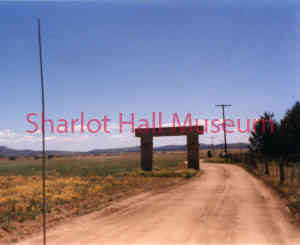Williamson Valley Cemetery
details
Unknown Unknown c0111px.jpg C-111 Color 1020-0111-0024 c0111px Print 3x5 Historic Photographs c. June 1985 Reproduction requires permission. Digital images property of SHM Library & ArchivesDescription
View of entrance at cemetery.
James Willard "Bill" Stewart (b. 1855 - d. 1930) arrived in the Arizona Territory in 1875 and had various jobs as a cowhand on many of the ranches in the Williamson Valley area, as well as in Coconino County. He returned to the Williamson Valley area, Simmons, Arizona, in 1886 and established the Cross Triangle Ranch, which later became a dude ranch.
Since 1886, this ranch has been bought and sold many times. Over the years, various people and families have made this ranch land their own and some have had family members died. The cemetery is small, with marked graves, but undoubtedly numerous unmarked graves. Dates on the headstones range from 1880-1922. Originally, it may have been a family or ranch area cemetery, as many of the names are limited to the same family names such as Allen, Harris, Koontz, Young, etc. Charles “Lon” Young, who died in 1913, was a Yavapai County Deputy.
Today (2018), this ranch is known as the Las Vegas Ranch Cemetery, but has been known by a variety of other names over the years, including Williamson Valley Cemetery, Granite Mountain Cemetery, Long Meadow Ranch Cemetery and Pierce Cemetery. This cemetery is on private property, and cannot be visited without permission from the current ranch owners - the Pierce Family.
Below are various identified markers and graves in the cemetery:
ALLEN
Charles Allen (b. 1846 – d. 1919)
Sarah E. A. Allen (b. 1883 – d. 1893)
BARRETT
Margaret “Maggie” E. (Young) Barrett (b. 1876 – d. 1899)
BOWMAN
Laura Viola (Allen) Bowman (b. 1888 – d. 1922)
COUGHRAN
Annie E. Coughran - Daughter of J.W. and N.G. COUGHRAN who died on July 29, 1891, 12 yrs and 8 months old.
CROXDALE
Julia/Ida (Patterson) Croxdale (b. April 1877/78 – d. April 14, 1910) – Wife to James Croxdale
DAVIS
Dr. M. G. Davis (b. March 31, 1865 – d. July 17, 1943)
FERGUSON
Elizabeth “Lizzie” (Harris) Ferguson (b. November 27, 1864 - d. January 18, 1914) - Daughter to Mary C. Harris and wife to Robert H. Ferguson
HARRIS
John M. M. Harris (b. December 6, 1860 – d. September 5, 1899) at 38 years, 8 months, 30 days
William F. Harris (b. August 25, 1869 - May 8, 1893) at 23 years, 7 months, 17 days
Edward J. Harris (b. May 14, 1875 - d. April 6, 1880) at 4 years, 10 months, 22 days
Mary C. Harris (b. July 19, 1834 – d. August 10, 1898) – Marker states “Mother”
Isaac R. Harris (b. January 31, 1867 – d. April 6, 1894) at 27 years, 3 months, 6 days
JOHNSON
Johnson Baby - Daughter of William S. and Daisy (Young) Johnson born and died on April 7, 1904, age 36 hours.
KOONTZ
John W. Koontz (b. 1847 – d. 1922) - Marker states “Father”
Charles Koontz (b. 1889 – d. 1916)
Harriet “Hattie” Jane Koontz (b. December 19, 1859 – d. December 18, 1907) - Wife of John Koontz
Phil Koontz (b. 1885 – d. 1889)
Elmer Koontz (b. 1896 – d. 1897)
LANE
Lawrence Lynam Lane (d. April 4, 1895) – Died from injuries in a mine accident
Ellen (Burger Merritt) Lane (d. 1891) – Died at 53 years old and is buried next to her daughter Sarah Marlow
MARLOWE
Joseph Marlowe (b. 1842 – d. May 1, 1911) Husband to Frances Bagley
Sarah “Sadie” Frances (Lane) Marlowe (No Dates) – Wife to Norman H. Marlow
NASH
Almira Nash (b. 1884 – d. 1906)
James Howard Nash (b. 1839 – d. 1914)
Third stone next to these two graves once had a plaque on the marble that has now been removed, but may have belonged to a member of Nash family.
NEAL
Frank W. Neal (b. 1879 – d. 1909)
ROBERTS
Osman W. Roberts (d. December 5, 1916)
SCULLY
Emma (Harris) SCULLY (b. August 7, 1872 – d. August 7, 1895) at 23 years old
WALKER
Osmana A. Walker (b. April 11, 1884 – d. July 30, 1909)
Elmora F. Walker (d. August 14, 1888) at age 1 month and 2 days
YOUNG
Robert Jefferson “Jeff” Young (b. February 2, 1865 – d. February 25, 1890) - Marker states “A good son, a kind brother, a faithful friend”
Lucinda “Lucy” Viola Young (b. 1867 – d. 1883)
DeWitt C. Young (b. 1829 – d. 1904) - Marker states “Father”
Charles Leonidas “Lon” Young (b. 1889 – d. 1913)
Emily Ann (Saunders) Young (b. 1844 – d. 1919) - Marker states “Mother”
Purchase
To purchase this image please click on the NOTIFY US button and we will contact you with details
The process for online purchase of usage rights to this digital image is under development. To order this image, CLICK HERE to send an email request for details. Refer to the ‘Usage Terms & Conditions’ page for specific information. A signed “Permission for Use” contract must be completed and returned. Written permission from Sharlot Hall Museum is required to publish, display, or reproduce in any form whatsoever, including all types of electronic media including, but not limited to online sources, websites, Facebook Twitter, or eBooks. Digital files of images, text, sound or audio/visual recordings, or moving images remain the property of Sharlot Hall Museum, and may not be copied, modified, redistributed, resold nor deposited with another institution. Sharlot Hall Museum reserves the right to refuse reproduction of any of its materials, and to impose such conditions as it may deem appropriate. For certain scenarios, the price for personal usage of the digital content is minimal; CLICK HERE to download the specific form for personal usage. For additional information, contact the Museum Library & Archives at 928-445-3122 ext. 14 or email: orderdesk@sharlot.org.




